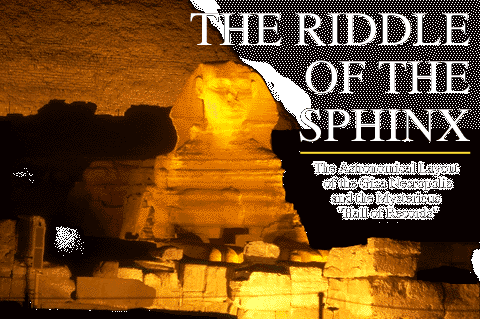

Editorial
|
Fragments
|
Aztalan
|
Carpet Rocks
|
Sphinx I
Register
for our Hall of Records Newsletter!
Questions? Comments? Suggestions? Advertising? Press Releases?
Contact us!
The Riddle of the Sphinx Part I
|
Part II
|
Part III
|
Part IV
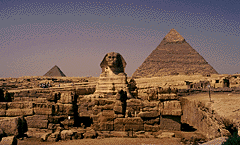
|
|
The Sphinx, seen from the front, with the pyramids of Khafre (right) and Menkaure (left)
in the background. Note that the pyramid of Menkaure is much smaller than the pyramid
of Khafre, giving the illusion of great distance.
|
 he term "The Riddle of the Sphinx" has an ancient heritage. The most well-known
reference to the Riddle, which you will encounter in most encyclopedias and
historical works dealing with ancient history and myth, comes from a Greek legend
of Oedipus. The legend describes a living, winged sphinx with the body of a lion
and the head of a woman, whose lair was situated on a cliff along the highway to
Thebes, one of the major cities of ancient Egypt. Whenever a traveler passed by
he term "The Riddle of the Sphinx" has an ancient heritage. The most well-known
reference to the Riddle, which you will encounter in most encyclopedias and
historical works dealing with ancient history and myth, comes from a Greek legend
of Oedipus. The legend describes a living, winged sphinx with the body of a lion
and the head of a woman, whose lair was situated on a cliff along the highway to
Thebes, one of the major cities of ancient Egypt. Whenever a traveler passed by
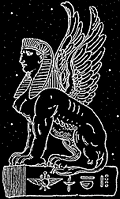 her lair, the Sphinx would challenge them to answer a riddle, or else she would
devour them. The riddle went something like this:
her lair, the Sphinx would challenge them to answer a riddle, or else she would
devour them. The riddle went something like this:
What animal is it
that in the morning goes on four feet,
at noon on two feet,
and in the evening on three feet?
Oedipus, however, realized the answer to the riddle: the "animal" was man who, in
the "morning" of his life crawls on all fours as an infant, in the "noon" of his
life walks on two feet, and in the "evening" of his life walks on three feet
(counting a cane as a third foot). Realizing she was undone, the sphinx cast herself
off of the cliff to her doom.
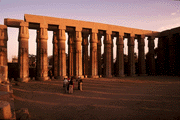
|
|
The Amen Temple, Luxor, Egypt.
Want to buy a book on Egyptian temples? Click
here.
|
One wonders, however, whether or not this story was an allegory for something deeper.
The Greeks were fascinated with Egyptian culture, and were forced to admit that Egypt's
mathematical, architectural, and astronomical achievements dwarfed anything Greece
had accomplished. Perhaps in their contacts with Egypt, and with the ancient but
fading Egyptian priesthood, faint echoes of their original myths made their way
into Greek philosophy and literature. And one of these, perhaps the most important
scrap of information that the Greeks were able to glean from the Egyptians, was that
there was a riddle to the Sphinx.
In 1993,
Serpent In the Sky
was published, wherein John Anthony West reiterated the idea first presented by the French
mathematician
R.A. Schwaller de Lubicz
that the Sphinx might actually be thousands of years
older than previously thought, based on what appeared to be water erosion on the Sphinx and
on the walls of the Sphinx enclosure. West consulted Boston University professor of Geology
Robert Schoch on the weathering patterns to be found on the Sphinx and the walls of the
enclosure surrounding the Sphinx, and Schoch found distinct evidence of long-term water
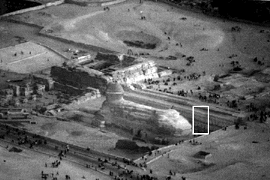
|

|
|
Left: The Sphinx viewed from the northwest, with a good view of the Sphinx enclosure.
The rear of the Sphinx was chiseled out of the limestone of the Giza plateau, creating
the enclosure area.
Right: A closeup of the rain-eroded walls of the Sphinx enclosure. Geologist Robert Schoch,
among others, has determined that this sort of undulating profile could only be created
by long-term exposure to heavy rains.
Click
here
to hear a sound clip from the video,
"The Mystery of the Sphinx", with John Anthony West, Robert Schoch, and narrated by Charlton Heston.
Both photos are from Graham Hancock and Robert Bauval's
The Message of the Sphinx,
pp. 177, 178 plates and 4 and 6.
|
erosion, a form of water erosion that could only be caused by regular, heavy rainfall. This,
of course, was quite shocking as, according to climatologists, the last time water fell in
any kind of significant quantity on Egypt had been some 5,000-7,000 years earlier! And since
the pyramids did not exhibit water erosion, the only conclusion that could be reached was
that the Sphinx had been carved out of the Giza plateau between 7000-11000 b.c., at least
4500 years earlier than the accepted date for the building of the pyramids. In short,
evidence now pointed to the idea that the Sphinx was not only not built at the same
time as the pyramids, but was probably several thousand years older!

The three main pyramids of Giza.
Bottom left: The Pyramid of Khufu
Center: The Pyramid of Khafre
Top right: The Pyramid of Menkaure. Note that the Pyramid of Menkaure is
significantly smaller, and out of line with the other two.
|
In 1995,
The Orion Mystery
was published. Robert Bauval, a Belgian engineer with a lifelong fascination with the
pyramids, often visited them and speculated with friends about how they were built, and
for what purpose. Studying aerial photographs of the pyramids, Bauval had wondered why the
third major pyramid, the "Pyramid of Menkaure", was so much smaller than the other two.
Moreover, he also noticed from aerial photographs of the Giza plateau that the Menkaure
pyramid was also not in line with the other two much larger pyramids, the so-called
"Pyramid of Khufu" and "Pyramid of Khafre" respectively. However, he filed this anomaly
away with the numerous other questions he had about the pyramids, giving it no more
precedence than any of the other mysteries surrounding the pyramids and Sphinx.
One night, he and a friend sat around a campfire talking about the rising of Sirius and
its relationship with the constellation of Orion. Bauval's friend explained to him how
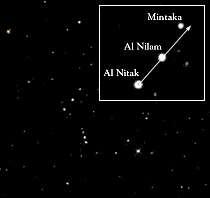 one can find the rising point of the star Sirius on the horizon by following the line
created by the three belt stars of Orion - Al Nitak, Al Nilam, and Mintaka - to the
horizon. As an afterthought, Bauval's friend also pointed out that the third star in the
belt, "Mintaka", was smaller than the other two, and also not quite in line with the other,
brighter stars.
one can find the rising point of the star Sirius on the horizon by following the line
created by the three belt stars of Orion - Al Nitak, Al Nilam, and Mintaka - to the
horizon. As an afterthought, Bauval's friend also pointed out that the third star in the
belt, "Mintaka", was smaller than the other two, and also not quite in line with the other,
brighter stars.
This, of course, clicked in Bauval's mind, as he had been long wondering why the Pyramid of
Menkaure was likewise noticeably smaller and off the line from the other two major pyramids.
Could there be a connection? Bauval then set off to compare more closely the alignments of
the three pyramids of Giza with the three belt stars of Orion, and found that the match was
nearly perfect.
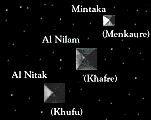
|
|
The three main pyramids of Giza, which mirror exactly the three belt stars in the
constellation Orion. Bauval, Hancock and others believe that this was an attempt by the
ancient Egyptians to create a "heaven on earth" in a very real sense.
|
In 1996, Graham Hancock, an award-winning writer for The Economist, and Robert Bauval,
author of
The Orion Mystery
cowrote
The Message of the Sphinx
(released in the U.K. as Keeper of Genesis), summarizing all of these new findings and many new ones
into a complete understanding of the "message" that they believed the pyramids and
Sphinx were intended to communicate. Their thesis was that the entire pyramid complex,
including the Sphinx, was intended to be a message written not in hieroglyphics, but
in stone.
Armed with the knowledge that (1) the Sphinx had been created several thousand years earlier
than the Pyramids, and (2) that the Pyramids were intended to be an earthly representation of
the belt stars of Orion, Hancock and Bauval were able to decode the Egyptian religion and myths as
described in the Pyramid Texts. Their conclusion was that the Egyptians, far from being
the confused, backward pagans they are typically portrayed as, were a very ancient, highly
sophisticated people with a religion based upon a very precise knowledge of astronomy.
In upcoming issues of Mysterious World, we will discuss in detail the exact nature of
Egyptian religion as discovered by Hancock and Bauval, and its significance to our understanding of
not only Egyptian history, but human history in general.
The Riddle of the Sphinx Part I
|
Part II
|
Part III
|
Part IV
Editorial
|
Fragments
|
Aztalan
|
Carpet Rocks
|
Sphinx I
Register
for our Hall of Records Newsletter!
Questions? Comments? Suggestions? Advertising? Press Releases?
Contact us!

Books

 The Message of the Sphinx:
The Message of the Sphinx:
A Quest for the Hidden Legacy of Mankind
(1997)
Graham Hancock, Robert Bauval
Rating:
    
A provocative new approach to Egyptology argues that the ancient
structures at Giza may be much older than originally thought and that their
alignment may be a cryptic message directed toward a mysterious underground chamber
recently detected beneath the Sphinx. In this riveting account of historical and
archaeological investigation, the authors present hard evidence that the Sphinx, the
Pyramids, and the other monuments at Giza are of far more ancient origin than previously
believed. Complete with evidence of a conspiracy between the Egyptology establishment
and various confidential organizations to keep the secrets of the Pyramids from the world,
The Message of the Sphinx is also a modern-day detective story. This popular book has
received many good reviews, and is personally recommended by the publisher.
Click
here
to buy this book.
 The Orion Mystery:
The Orion Mystery:
Unlocking the Secrets of the Pyramids (1995)
by Robert Bauval, Adrian Gilbert (Contributor), Peter Ginna (Editor)
Rating:
    
This fascinating archaeological detective story argues that the great pyramids
of Egypt's Fourth Dynasty (c. 26002400 b.c.) were vast astronomically
sophisticated temples, rather than the pharaonic tombs depicted by
conventional Egyptology. Mysterious airshafts, which lead from the Great Pyramid's
chambers to its exterior were sited, the authors argue, to coincide with the key stars of
Orion, a constellation that had religious significance for the Egyptians. Using
astronomical data about stellar movement, they argue that the Orion stars
coincide exactly with the pyramids' positions in approximately 10,400 b.c.--a
period the Egyptians called the First Time, when they believed the god Osiris
ruled the Earth. This excellent book makes a good companion volume to Hancock's
"The Message of the Sphinx", which it preceded.
Click
here
to buy this book.
 The Serpent in the Sky:
The Serpent in the Sky:
The High Wisdom of Ancient Egypt
(1993)
John Anthony West
This revised edition of West's revolutionary reinterpretation of the civilization of Egypt
challenges all that has been accepted as dogma concerning this ancient and enigmatic
land. It features a new introduction linking Egyptian science with the perennial wisdom
tradition and an appendix updating the author's work in redating the Sphinx.
Illustrations.
Click
here
to buy this book.
 Riddles of the Sphinx
(1998)
Riddles of the Sphinx
(1998)
Paul Jordan, John Ross (Photographer)
This book tells the full story of the Great Sphinx of Giza as Egyptology has
uncovered it. The Sphinx is one of the most striking monuments of the ancient
Egyptians, and has attracted the attention of travellers, scientists, archaeologists
and others for generations. Paul Jordan details the Sphinx's impact on the
ancient world, on Arab writers, on Renaissance travellers, on the pioneers of
Egyptology and on modern scholarship. He tells the story of the Sphinx's many
bouts of excavation and restoration, and above all puts the Sphinx in the
context of all that is known about ancient Egyptian history and religion. This
book examines every aspect of the Sphinx, including a professional geologist's
recent claims regarding its age, and provides an authoritative and highly
readable overview of the issues and debates currently surrounding it.
Click
here
to buy this book.
 Temples of Ancient Egypt
Temples of Ancient Egypt
Dieter Arnold (Editor), Lanny Bell,
Ragnhild Bjerre Finnestad (Editor), Byron E. Shafer (Editor)
Click
here
to buy this book.
 The Cambridge Star Atlas
(1996)
The Cambridge Star Atlas
(1996)
Wil Tirion
After having established itself as a standard star atlas, "The Cambridge Star Atlas"
by internationally famous astronomical cartographer, Wil Tirion, has now been
improved. The popularity of this book, first published in 1991, is that it covers the
entire sky, both northern and southern latitudes, in an attractive format suitable for
beginning as well as experienced astronomical observers. The basis of the book is a
series of twelve monthly sky charts, followed by an atlas of the whole sky, arranged in
twenty overlapping charts. Each chart shows stars down to magnitude 6.5, together
with about 900 nonstellar objects, such as clusters and galaxies, that can be seen with
binoculars or a small telescope. There is also a comprehensive double-page map of
the Moon's surface, showing craters and other named features. For this edition, author
Tirion has added more detail to the monthly charts, and has included "all-sky" charts of
interesting patches of sky in the northern and southern hemispheres. This book is the
ideal reference atlas for sky watchers everywhere.
Click
here
to buy this book.
 NightWatch
(1989)
NightWatch
(1989)
Terence Dickinson
Dickinson, a renowned writer and former planetarium astronomer teaches you all the
basics to star gazing, including: key facts of stargazing equipment (binoculars and
telescopes), 24 seasonal star charts, "the universe in eleven steps", chapters on the
planets; moon & sun; eclipses; comets, meteors & auroras; photographing the night
sky; and essential resources.
Click
here
to buy this book.
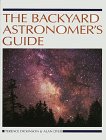 The Backyard Astronomer's Guide
(1991)
The Backyard Astronomer's Guide
(1991)
Terence Dickinson, Alan Dyer, Barry Estabrook (Editor)
An essential reference tool for both beginning and veteran sky observers. Drawing on
decades of stargazing experience, the authors suggest what equipment to buy and
what to avoid, describe observing techniques, and explain how to hunt down the most
interesting celestial objects. Each chapter is illustrated with the latest, breathtaking
astrophotography. This book is recommended as an excellent companion to "NightWatch" (above).
Click
here
to buy this book.
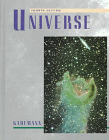 Universe
Universe
4th Edition (1993)
William J. Kaufmann III
Rating:
    
This oversized tome is an excellent introductory overview of all aspects of modern astronomy.
I first encountered this book as a textbook to an introductory astronomy class, and it has
been an indispensable tool ever since, as it has to countless other students of astronomy.
This popular book has received many good reviews, and is personally recommended by the
publisher.
Click
here
to buy this book.
 The Photographic Atlas of the Stars (UK edition)
(1997)
The Photographic Atlas of the Stars (UK edition)
(1997)
by P. Doherty (Contributor), P. Moore (Contributor), H. J. P. Arnold (Photographer)
Click
here
to buy this book.
Audio
 Passion: Music for the Last Temptation of Christ
Passion: Music for the Last Temptation of Christ
Peter Gabriel
Rating:
    

This CD received superb reviews (5 stars) and is personally recommended by the publisher.
(The background music on this page is from "The Feeling Begins", the first track of this CD.)
Click
here
to buy this music.
 Passion: Sources
Passion: Sources
Peter Gabriel/Realworld Music
Rating:
   

This excellent CD is a compilation of much of the source recordings that Peter Gabriel
used for Passion (above). A must-have for lovers of world music, especially African and
Middle-Eastern music.
Click
here
to buy this music.
 The Musicians of the Nile: Luxor to Isna
The Musicians of the Nile: Luxor to Isna
Musicians of the Nile
Rating:
   

Life in the villages spread out along the Nile hasn't changed in a thousand years; nor
for that matter has the traditional music of the region which has remained impervious to
outside influences, even Islamic ones. The recordings here weren't collected on site but
captured live at a Paris concert and in Real World's own studios in darkest Wiltshire.
No concessions are made to Western ears, however, other than upping the playback
quality of the intricate tabla rhythms as they tangle with ancient instruments like the
rababa, the droning oboe-like mizmar and the flutish arghul which goes all the way
back to the Pharaohs. Not so much a record, more like an adventure in sound. This
soundtrack is highly recommended by the publisher.
Click
here
to buy this music.
Video

 The Mystery of the Sphinx
(1993)
The Mystery of the Sphinx
(1993)
John Anthony West, with Robert Schoch
Rating:
    
Click
here
for a sound sample!
The Mystery of the Sphinx contains information about the Sphinx, and Egyptian history and
archaeology in general, that is nothing less than explosive. John Anthony West and Robert
Schoch offer brilliant and convincing evidence that the Sphinx is much older than the
pyramids, possibly as much as 8,000 years older than previously thought, indicating that
our understanding of Egyptian history and religion has barely scratched the surface. Their
convincing testimony is made all the more interesting and entertaining by the inclusion
of Charlton Heston as the narrator. And this video is not merely a visual montage of Egyptian
images overlaid with mystical-sounding rhetoric. This is real science and real history -
and maverick archaeology at its best. This popular video is highly recommended by the
publisher.
Click
here
to buy this video.
|

